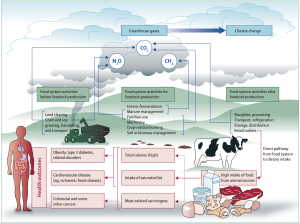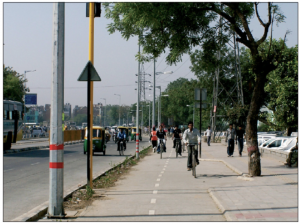Enoku Sai
As the climate change has more and more severe impacts on earth, we need to tackle this issue more seriously. At the same time, we also have to take care of other social issues such as human health problem. Referring several researches, it is shown that we are able to implement environmental policies together with human health policies and improve both conditions. In order to save time and limited resource, it is important to balance the resource to solve each social issue.
Introduction
As recently more and more people are getting aware of environmental issues, many environmental policies have been made and conducted. Urgent and ambitious measures are required to mitigate and adopt the global climate emergency and a large amount of resource is needed to be invested. At the same time we have to deal with other uncountable social issues such as health, poverty or education and split the whole resource to other tasks. Moreover, considering large influences from climate change, we will realize that climate change affects these other issues as well. Therefore we as human need to minimize impacts from climate change and improve other social conditions together. The best way to do this is creating effective solutions that can work crossing many fields.
For this article, I would like to discuss the relationship between climate change and human health problems and how to improve both conditions together and discuss about co-benefits of environmental policies. I would like to explain the current situation in each area and show two simulation researches on how policies can affect environmental and health issues at the same time.
Reducing animal products
Animal products, such as livestock are responsible for a large portion of global Green House Gas(GHG) emissions. According to the research, the livestock sector contributes 14.5% of global GHG emission and especially beef and diary cattle account for most of the emissions from livestock sector.[1] As global population will still continue to increase in the coming decades, the consumption of animal products will also rise, which means that environmental influence from livestock sectors will expand continuously. From the perspective of health, animal products have possibilities of resulting worse human health conditions. Concretely, cardiovascular diseases can be caused by eating saturated fat. Moreover, consumption of high-fat and energy-dense diet is associated to increased risk of obesity, and in the case of red meat, increased of cancer and mortality.
In 2009, the research on public health benefits from agriculture and food systems was conducted and its result shows that due to the certain amount of livestock reduction, public health benefits can be obtained.[2] As one of the results from this research, the mechanism of how climate change and health issues link to livestock sector was presented in Figure 1. This figure shows that reducing the amount of animal food products can be a solution of both problems.

Figure 27.1 – Figure1. Processes in the food and agriculture system that lead to greenhouse-gas emissions and population health outcomes
Considering targets of GHG emissions reduction, 30% of substitution of saturated fat by polyunsaturated fat is used in this study. In UK, the reduction of 30% of saturated fat consumption from animal products could reduce the total burden from ischaemic heart disease by 15% in DALYs, by 16% in years of life lost and by 17% in number of premature deaths. In São Paulo city, 30% reduction in intake of saturated fat from animal sources could reduce the total burden from ischaemic heart disease by 16% in DALYs, by 17% in years of life lost and by 17% in number of premature deaths. Health benefits are described by unit of DALYs (Disability-adjusted life-years), YLL(Years of Lost) and premature deaths. DALYs means lost years of healthy life due to disease or injury and YLL means lost years of life due to disease or injury. [3]
Basically from this result, the substitution of saturated fat from animal food by plant-based fat is playing an important role in accomplishing environmental targets and improvement of public health. What should be noted is that animal products have benefits from nutritious perspective. Especially in poor countries, there are not enough plant-based fat that can substitute nutrition such as iron or zinc that we usually obtain from animal food. Therefore the key point is that considering current over consumption of animal food, the distribution of food in proper ways is important with reducing amount of meat production in rich countries.
Shift of transportation systems
The second example is the transition of transportation system.
At the moment, transportation sector including public and private transportation is the one of the largest GHG generators in the world especially in developing countries. Not only global warming, but also the air pollution problem arose from transportation activities. Numerous studies on the transportation issues and results form these researches have shown that transportation is responsible for about 14% of GHG emissions from economic sectors and the amount of GHG emissions has been still increasing. [4] It should be noted that compared to 1970, the amount of emissions doubled in high income countries and more than doubled in Upper middle income and Lower middle income countries. Moreover it is estimated that this trend would continue in coming decades without ambitious targets and policies. From health perspective, modern urban transportation systems resulted in reduced outdoor activity, increased outdoor air pollution and traffic jams, which affect human health badly in many ways. Nitrogen dioxide, particulate matter or sulfuric acid will cause health diseases directly, which is now seriously affecting people’s life in developing countries such as China and India.
According to the research on the scenario analysis of relationship between reduction of GHG emissions and health benefits in London and Delhi, since motor vehicles are the drivers of GHG emissions, air pollution and traffic injuries, increasing active travels such as riding bikes and walking resulted in both larger environmental and health benefits.[5] We could obtain large benefits under scenarios of car reduction. For London, if we would reduce car utilization by 35%, we could save 7439 DALYs and 541 premature deaths per million population. For Delhi, under the scenarios of reducing car utilization by 60%, we could save 12995 DALYs and 532 premature deaths per million population. This result means that for this issue, the mitigation policies of climate change through reducing current traffics and shifting to new transportation systems can lead to large positive impacts in both environmental and health issues.

Figure 27.2 – Image: New bicycle facilities in Delhi, India
There are several reasons for this improvement. First, increased physical activities help to keep our body healthy both physically and mentally. Instead of riding vehicles, walking will increase the movement of muscles. Physical body movements can help reduce duration of depressing and the incidents as well. Second, reducing traffic on roads can lead to smaller number of premature deaths and DALYs through reductions in the rate of mortality caused by air pollution. This result performed more significantly in developing countries than in developed countries because often technologies used in vehicles are poorer and people care about environmental issues less. In addition, the regulation is not enough provided to prevent from emitting large amount of pollutants. Third, switching transportation systems from driving vehicles to walking or cycling reduces accidents happened per km travelled because of high accident rates of driving vehicles. What should be noticed, however, is that though walking and cycling are safe transportation options per km travelled compared to driving vehicles, the large increase in total distance of walking and cycling can result in the rising road traffic injury.
Conclusion
With two above examples, several environmental policies can bring large positive impacts in the health area. With limited money resource, it is effective to invest money in policies that can link two issues together. The main point is that balancing is the most crucial point that we can learn from these two examples. If we could not manage to balance and put too much weight in one area, the policy would end up ruining itself. In order to keep co-benefits work effectively, careful assessment and simulation are essential.
References
[1]Gerber et al., 2013, “Tackling Climate Change Through Livestock: A Global Assessment of Emissions and Mitigation Opportunities”, Food and Agriculture Organization of the United Nations
[2]Sharon Friel et al., 2009, “Public health benefits of strategies to reduce greenhouse-gas emissions: food and agriculture”, www.thelancet.com, Vol 374, 2016- 2025
[3] https://www.who.int/healthinfo/global_burden_disease/metrics_daly/en/
[4] https://www.ipcc.ch/report/ar5/wg3/
[5]James Woodcock et al., 2009, “Health and Climate Change 2 Public health benefits of strategies to reduce greenhouse-gas emissions: urban land transport”, “The Lancet”, 374(9705):1930-43
Media Attributions
- Screen shoot 2020-03-29 1.57.54
- Screen shoot 2020-03-29 2.48.37